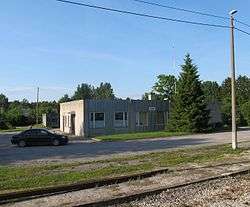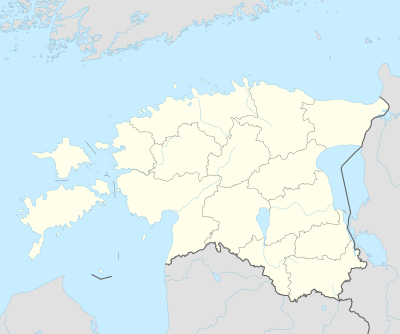Püssi
| Püssi | |||
|---|---|---|---|
| Town | |||
 Püssi railway station | |||
| |||
 Püssi Location in Estonia | |||
| Coordinates: 59°22′N 27°03′E / 59.367°N 27.050°ECoordinates: 59°22′N 27°03′E / 59.367°N 27.050°E | |||
| Country | Estonia | ||
| County | Ida-Viru County | ||
| Municipality | Lüganuse Parish | ||
| First mentioned | 1472 | ||
| Borough rights | 1954 | ||
| Town rights | 1993 | ||
| Population (2012[1]) | |||
| • Total | 1,783 | ||
| • Density | 849/km2 (2,200/sq mi) | ||
| Time zone | UTC+2 (EET) | ||
| • Summer (DST) | UTC+3 (EEST) | ||
| Website |
pyssilv | ||
Püssi is a town in Lüganuse Parish, Ida-Viru County, in northeastern Estonia, with a population of 1,783 as of 2012.[1][2] It is located near the road between Tallinn and St. Petersburg.[3]
History
Following the end of the Soviet Union's 45-year rule over Estonia, Püssi saw a sharp economic downturn and a population exodus.[2] In 1989 the population of Püssi stood at 2,400 people,[2] and 20 years later, in 2009, was only 1,809. The population has continued to decrease and by 2012 stood at 1,783 people.[1] In October 2013, Püssi along with Maidla Parish were merged into Lüganuse Parish, and therefore ceased to exist as sovereign municipalities.
Economy
By 2002 Püssi had accumulated 20 million kroons of debt, the equivalent to 1.3 million euros; and property values had become so low that apartments were valued around zero. Since then, the city's economy has begun to recover. Püssi has planned the construction of an industrial park. The Chairman of the town council, in an interview with The Baltic Times, marketed Püssi by stating that property values in the city were only 1% of those of the capital city of Tallinn.[2]
Püssi has historically served as a production center for particle board. At the time of the collapse of the Soviet Union, the town's largest employer was particle board manufacturer Repo Vabrikud, which employed 1,400 people, over half the city. Although Repo Vabrikud has scaled back employment significantly,[2] other particle board manufacturers have moved in. Sorbes Group has the production center for its "Repo by Sorbes" line of particle board in Püssi.[3] In 2011, the Estonian furniture manufacturer Viisnurk took over an inactive softboard factory in the city with the intention to manufacture softboard for international clients in Asia and Europe.[4]
In December 2010, Siemens announced that Püssi had been selected as the location of one of two converter stations for their "EstLink 2" high voltage power line between Estonia and Finland.[5]
Culture
Püssi is the home of the Püssi Punk Festival, which has run annually since 2005, and features rock, metal, blues, and indie musicians from several countries.[6][7]
The town contains an artificial mountain made of ash from an oil shale power plant that has been depositing ash in the location since the 1930s.[8] The mountain is used for motocross racing.[3]
Notable person
Painter Carl Timoleon von Neff (1804–1877) was born in Püssi.[9]
References
- 1 2 3 "PO0291: POPULATION NUMBER, AREA AND DENSITY BY ADMINISTRATIVE UNIT OR TYPE OF SETTLEMENT, 1 JANUARY". Statistics Estonia. Statistics Estonia. Retrieved 14 January 2013.
- 1 2 3 4 5 Charles, Alec. "Pussi galore: the renaissance of an Estonian town". The Baltic Times. Baltic News LTD. Retrieved 14 January 2013.
- 1 2 3 "About Estonia". Sorbes Group website. Sorbes Group. Retrieved 14 January 2013.
- ↑ "Estonian furniture maker Viisnurk acquires softboard factory". Invest Estonia website. Estonian Investment Agency. Retrieved 14 January 2013.
- ↑ "Siemens to supply converter stations for HVDC connection between Estonia and Finland – Transmission capacity between the two countries to increase threefold" (PDF). Press Release. Siemens AG. Retrieved 15 January 2013.
- ↑ "Püssi Pungist sai kahepäevane festival". Virumaa Teataja (in Estonian). Postimees. Retrieved 14 January 2013.
- ↑ "Estonian Trio to Headline Blues Night at UK's Only Dylanfest". Estonian Embassy in London website. Estonian Embassy in London. Retrieved 14 January 2013.
- ↑ Pae, Taavi; Aarne Luud; Eedi Sepp (2005). "ARTIFICIAL MOUNTAINS IN NORTH-EAST ESTONIA: MONUMENTAL DUMPS OF ASH AND SEMI-COKE" (PDF). Oil Shale. 22 (3): 333–343. Retrieved 15 January 2013.
- ↑ Abel, Tiina (2004). "Art Collection as a Manifesto". Estonian Institute. Archived from the original on 5 October 2013. Retrieved 15 February 2013.
External links
| Wikimedia Commons has media related to Püssi. |

